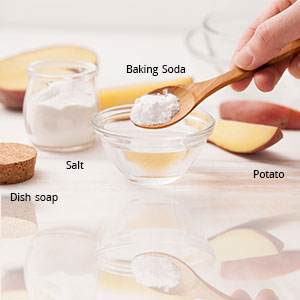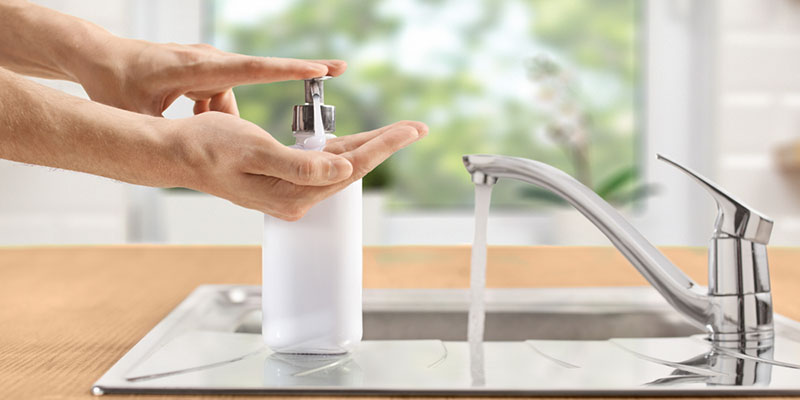How To Remove Rust From Stainless Steel Sink

Stainless Steel Sink
Stainless steel can go for a long time, it’s a fact. But when you fail to maintain it properly, there are chances of facing rust spots on stainless steel. In this case, you need to know how to remove rust from stainless steel.
Well, that’s not an uphill battle. In this article, we have come up with every relevant piece of information regarding this topic including some actionable steps to remove rust from stainless steel. Also, there’s an FAQ section that will help you to get rid of any confusion.
Enough beating around the bush, let’s get to the point now.
How Does Rust Happen on Stainless Steel Sink
The name ‘stainless’ itself makes people think that stainless steel doesn’t have stains or rusts. Yes, this metal doesn’t rust so often that the other metals do. However, there are times when stainless steel also becomes rusty.
Sinks are highly prone to scratching, for this, you need to strictly avoid using abrasive cleansers while cleaning your stainless steel sink. Moreover, investing in good-quality stainless steel is equally important. Otherwise, there are chances of getting rust stains.
The main culprits behind rust stains on your sinks are-
- Cast-iron or other metal pans left to soak for a long time
- Iron in the water. You can have an iron filter to make sure of this issue.
- Flatware or utensils left in the sink
- Metal cans of vegetables or pet foods set in the sink
- Colored towels or wet sponges
- Abrasive cleaners or dish soaps (more specifically, when housed in metal containers)
- A rusty water heater, pipes, or fixtures can be the reason for presenting rust particles in the water supply. In this case, you may need to replace the pipes or the water heater.
- Extremely high temperature (750-1,550)℉
- Lacking chromium content on the surface of stainless steel sinks. When the surface is scratched off because of using steel wool (for cleaning purposes), there’s a chance of lowering the level of chromium content here.
6 Easy Methods to Remove Rust From Stainless Steel Sink
Do not be afraid of the culprits that cause rust on your sink. There are some excellent ways to remove rust spots without harming your sink. Hence, we have laid out 6 easy-to-follow methods that will help you.
 Method 1: Baking Soda Paste
Method 1: Baking Soda Paste
Starting with a simple yet excellent rust-removing method. It works great to vanish rust and spots on your stainless steel sink.
It’s also okay to use baking soda paste to clean your sink any time because it offers enough abrasive power for removing spots without damaging your sink.
Things You’ll Need
- Baking soda
- A paper towel
- A soft-bristled brush
- A nylon scrub pad
Step-Step Process
- Take a bowl and pour a little water into it.
- Add one or two tablespoons of baking soda for creating a paste.
- Rinse the sink with water or use a wet paper towel to wipe it down. It will moisten the areas that need a rust treatment.
- Point on the affected areas and apply the paste on them.
- Use a soft-bristled brush (e.g fingernail brush or an old toothbrush) to scrub the area. Do this job gently.
- If you find the spots aren’t fading properly, use a nylon scrub pad or a dish-scrubbing scrub sponge to scrub the sink. With mentioning, these scrubbers are safe for stainless steel.
- Rinse the area.
You should see a rust-free, shiny sink after following the steps. However, if you see the spots still remain, then sprinkle a fair amount of baking soda liberally over the rust spots. Then, leave it alone and for 30 minutes so that it sits properly. Finally, scrub and rinse the area.
Method 2: Potato Trick
Are you frowning to read the term ‘potato trick’? Trust me, it works great to remove rusts on stainless steel. Mainly, the superhero is ‘oxalic acid’ that naturally comes in many food plants (e.g potatoes, parsley, and spinach).
This rust remover is not very abrasive and declared totally safe for stainless steel.
Things You’ll Need
- Potato
- Salt/baking soda
- Dish soap
Step-Step Process
- Slice a potato in half.
- Cover the open part of the potato with dish soap.
- Sprinkle salt or baking soda onto the open end of your potato. Salt or baking soda will work here as a mild abrasive and help to scrape off the rust.
- Rub the cut end of the potato over the rusty areas.
- Wait a few minutes.
- Rinse the area well.
- Let the sink dry.
If the stains still remain, keep the potato and let it sit for a few more minutes. Then, scrub and rinse the areas.
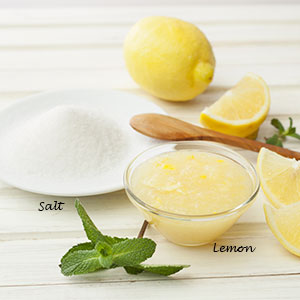 Method 3: Lemon and Salt
Method 3: Lemon and Salt
In this method, you will have both the acidity of the lemon and the abrasive nature of salt. See, things that needed for this method are near your elbow, some easily-available households.
So, this one is probably the simplest method we’re talking about.
Things You’ll Need
- Lemon or lime juice
- Salt
- Wire brush
Step-Step Process
- First of all, cover the rusty areas on your sink with salt.
- Slice a lemon in half.
- Squeeze the lemon and collect the lemon juice.
- Pour the lemon juice over the salt-coating.
- Let the mixture sit for around 2 hours.
- Use the lemon rind for scrubbing purposes.
- Rinse the area well.
In case, you notice the rust spots are not completely gone, scrub them off using a wire brush.
When the rust is completely gone, rinse the lemon, salt, and rust residue. Finally, let the sink dry and enjoy the shine.
Method 4: Using Vinegar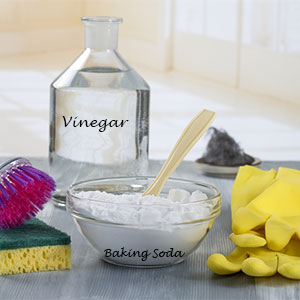
Here’s a simple, ‘let sit and forget’ type of method. Vinegar is widely used for removing rusts from stainless steel sinks.
Also, people use vinegar to clean day-to-day used kitchen appliances and utensils.
Things You’ll Need
- Vinegar
- Baking Soda
- A metal sponge
- Clean cloth
Step-Step Process
- Firstly, take a clean bowl.
- Add 1 part vinegar and 1 part soda in the bowl.
- Clean the sink only with water to make the areas wet.
- Apply the vinegar mixture over the rusty areas.
- Leave on for an hour.
- Rub with a metal sponge.
- Rinse the area.
- Use a clean cloth to dry it well.
Hopefully, you will get back your rust-free, sparkling kitchen sink.
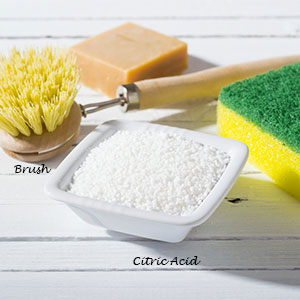 Method 5: Applying Citric Acid
Method 5: Applying Citric Acid
Wait, do not worry much because citric acid is not that available around your households, you can easily purchase it from almost any health and food stores.
Using citric acid to remove rust is not that famous but it works like a pro.
Things You’ll Need
- Citric acid
- Hot water
- Brush
Step-Step Process
- First of all, take a bowl and fill a few inches of hot water in it.
- Pour 2-3 tablespoons of acidic acid into the water.
- Pour this mixture onto the rusty areas.
- Leave it for a couple of hours.
- Scrub off the rust flecks residue with a brush.
- Use fresh water to rinse the area and then pat dry.
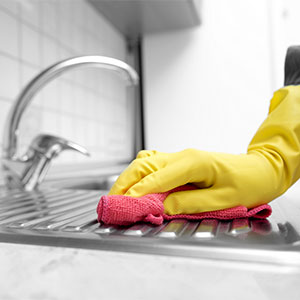 Method 6: A Commercial Stainless Steel Cleaner
Method 6: A Commercial Stainless Steel Cleaner
If you find all of the previous methods useless, then here’s a way for you- using a high-powered cleaner.
Most of the commercial cleaning products contain active against that work like a champ removing the most drastic rust.
Things You’ll Need
- Stainless steel cleaner
- Safety glasses/goggles
- Mask or respirator
- Damp sponge
- Gloves
- Clean cloth
Step-Step Process
- First thing first, put on the safety gear.
- Dampen a sponge with a good-quality cleanser. A little amount is okay for a large area.
- Apply the polish very gently to all the rusty areas.
- Continue rubbing until all the stains are perfectly gone.
- Use fresh water to rinse the area.
- Dry it with a clean cloth.
Voila! You now know how to remove rust from stainless steel sinks in the right way.
How to Prevent Rust on Stainless Steel Sink
Being careful from the first days is and preventing rust on stainless steel is easier than removing drastic rust spots. For making your path smoother, here are some preventions you should follow.
- When you clean up the sink, avoid using any metal scouring pad because this can scratch the metal and damage the protective layer that works to prevent rust. Also, these can leave metal particles that will be trapped within your sink scratches and lead to rusty spots.
- Always scrub in the direction of the polishing marks on your metal. It will help keep the stainless steel looking sparkling.
- Do not use bleach or cleaners that contain chlorides or any harsh chemicals. In case, you’ve used bleach for cleaning other items in your sink, rinse the sink thoroughly, and use a towel to dry it.
- Do not soak any item (in bleach solutions, soapy water, or salty water) for a long time in your sink.
- Do not use abrasive cleaning products.
- Avoid using sandpaper or steel wool to scrub off the rust. It may remove the rust for a while, but your sink may get ugly marks on the surface.
- If you notice water stains, tarnish, or discoloration on the surface, rinse your sink using adequate clean water and make sure you remove all the accumulated chemicals.
- Invest in high-quality stainless steel.
Additional Tips to Get a Sparkling Sink
Stainless steel will not get stains if you maintain it regularly. This metal requires daily maintenance to look its best. However, it’s easy to use and maintain stainless steel, you just need to do the job regularly. So, avoid putting off today’s work for the next weekend to see the best look of your sink.
Here you go with some tips that will keep your stainless steel sink sparkling.
- Rinse your sink using hot or warm water once a day. This will help remove the remaining soap or other materials left behind from your washed items.
- Dry the sink afterward (optional) to make sure it prevents water spots.
- Sprinkle a dash of baking soda as a weekly cleaner when your sink is damp. Scrub any spots in your sink using a sponge. Rinse your sink using a little white vinegar. It will disinfect the sink as well as remove mineral deposits. Finally, rinse the sink using plain water.
- Use white vinegar to wipe the faucet and edges of your sink. This will eliminate water spots and make the metal sparkling.
- Slice a lemon in half and coat the open end of it with cream of tartar. Then, rub the cut end over your sink and buff it with a cloth. Finally, rinse and wipe out your sink. Doing this regularly will help remove rusty spots.
Frequently Asked Questions
Conclusion
Are you still confused about how to remove rust from stainless steel sinks? Standing on the ending point of such an informative article, we hope your answer is a big NO.
Think about it, getting rust on the sink is not so easy while it is made of stainless steel. If you keep it clean and maintain it regularly, there is a little chance of your sink having rust spots. So, keep this in your mind and yes, if you somehow fail, there are ways to remove rust spots as well.
Try to follow each method carefully and you will do the job perfectly.
Good luck!

